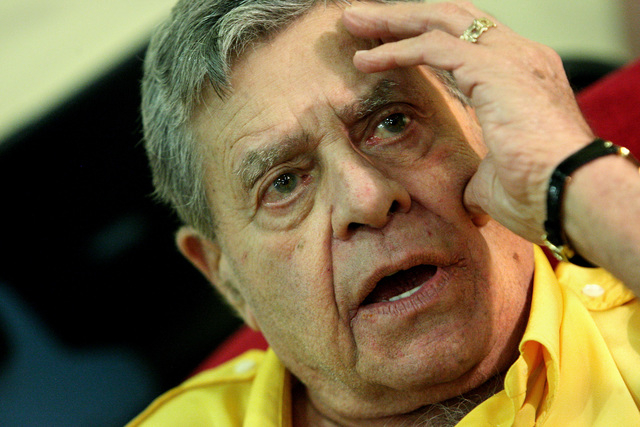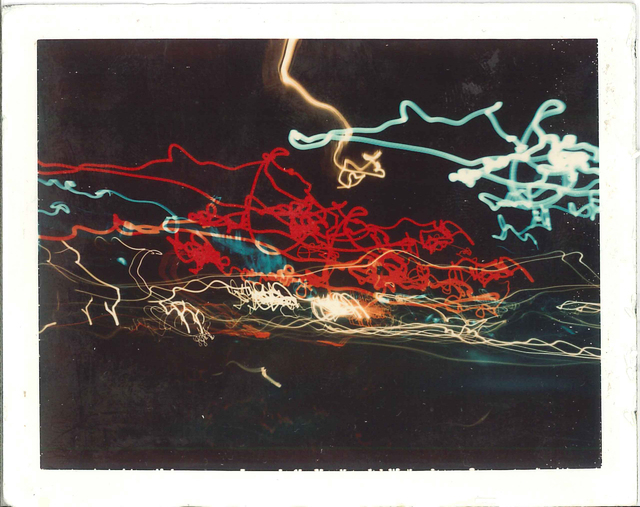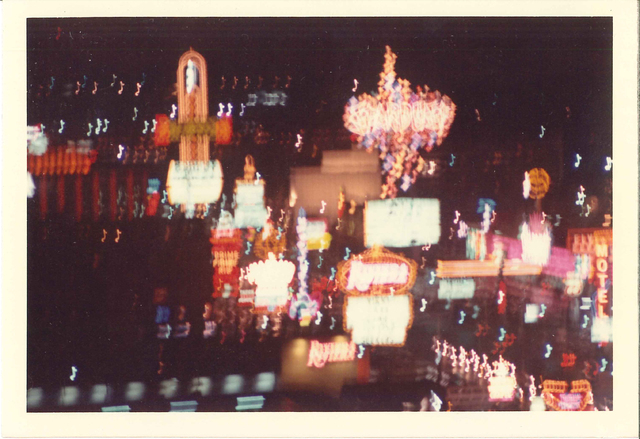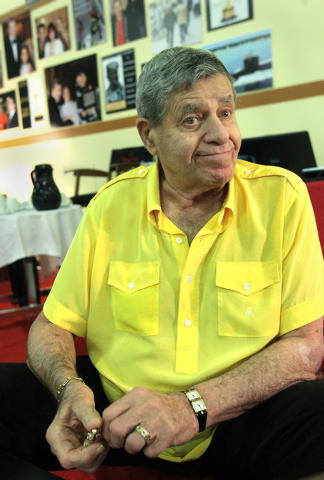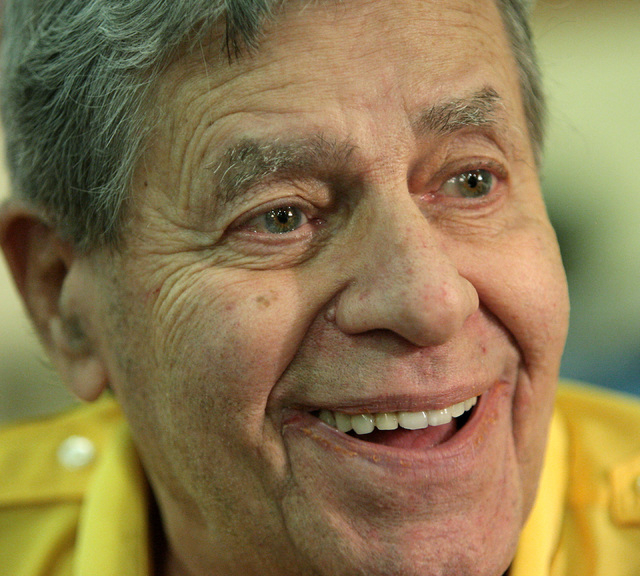Jerry Lewis shares his photographs in UNLV exhibition
Jerry Lewis always has been associated with pictures — moving pictures, that is.
After all, the comedy legend (and longtime Las Vegan) has directed more than 20 movies and appeared in about 50 more.
During his Hollywood heyday, however, Lewis also trained his eye — and camera — on another type of pictures.
He dubbed them “Painted Pictures” — and they’re the focus of a new exhibit opening Friday at UNLV’s Marjorie Barrick Museum.
“The pictures were for my own enjoyment,” the 88-year-old Lewis says in an email interview.
“I had no intentions of ever sharing the pictures.”
That is, Lewis says, until longtime friend Michael McGraw told him “they were ‘relevant and modern’ and should be shared.”
McGraw contacted Michele C. Quinn of MCQ Fine Art, who wound up curating the Barrick exhibit, after cataloging the photographs with the help of three UNLV interns.
More than 200 images, mostly abstract in style, were selected from hundreds of “Painted Pictures” Lewis had stored in a warehouse “full of memorabilia,” Quinn notes. Altogether, she and the UNLV students “documented over 600 works, all photographs, and 90 percent were what Jerry calls his ‘Painted Pictures.’ ”
Reasoning that “every great director always carries a camera,” Lewis shot most of his “Painted Pictures” in the 1960s and ’70s.
“The photos bring back many memories of traveling through the world,” he says. “Some were taken in Mexico City, Piccadilly (Circus in London), Paris ... Las Vegas, and on the streets from my car. Some images are of cars coming and going, and others are from lighting on the sets of my movies.”
According to Quinn, about 150 of the displayed images are small — 3½ by 5½ inches — and 54 others are larger, 11-by-14-inch prints.
A few are early Polaroid shots and “the rest are Kodak prints.”
In other words, film.
“When cameras were cameras, not digital, you could do so much with a camera,” Lewis writes. “All of these pictures were a manipulation of shutter speed and light. Matches, cars, neon signs, etc.”
Some of those images are blurry but recognizable, including a shot of the Strip — dominated by the neon marquees of such long-gone casinos as the Stardust and Frontier.
Other photographs explode with abstract energy, depicting dancing red and yellow lines, or streaks of intertwined red, white and blue lights.
“I think people are really going to be amazed by the quality of the images,” Quinn says, noting how Lewis used “light tracings as sort of a paintbrush stroke” to achieve his effects.
“All the creativity was in taking the photos and experimenting with the camera,” Lewis reflects, citing film speed and lenses as two of the variables in the experiments.
“Sometimes I would set up several cameras to shoot at different times to catch the images,” he explains. “I could hear the thunder but could not capture it in a photo so I would concentrate on the lightning. You had to be quick!”
And in a nondigital era, “you had an idea of what you were shooting but could not tell until the photos were printed” how well they’d turned out, Lewis says. “No save, delete, etc., like today.”
That Lewis’ abstract images were “actually done with the camera” ranks as “the amazing part of it,” in Quinn’s view.
After all, “we’re so used to manipulated photographs” these days, thanks to Photoshop and other high-tech tools, she points out. “If you really put it into the context of place and time, it’s very groundbreaking.”
UNLV galleries director Jerry Schefcik agrees with that assessment.
These days, lots of “artists use light and move a camera,” Schefcik says. “Right now, it’s not innovative. But considering he was doing it some time ago,” Lewis’ “Painted Pictures” have considerable impact.
“There’s mystery and there’s intrigue,” he says — which may prompt museum visitors to wonder, “ ‘How did these come about? Where were they taken?’ ”
As for who captured the images in the first place, “take the celebrity out of it,” Quinn says. “For me, I typically don’t want to do anything with celebrities, because it tends to distract” from the inherent quality of the work involved.
In the case of Lewis’ “Painted Pictures,” however, “these works really stand out,” she says. “Too many artists are one-hit wonders,” but “this work really does stand out on its own.”
The Barrick exhibit includes several reminders that Lewis is hardly a one-hit wonder.
A retrospective of original movie posters also will be on display, along with documentary footage chronicling Lewis’ big-screen success as star, director, producer and/or writer of such comedy classics as “The Nutty Professor.”
(Among the talking heads: Oscar-winning director Steven Spielberg, “talking about how important Jerry is,” Quinn notes.)
And speaking of movies, a screening of 1963’s “The Nutty Professor” — which Lewis co-wrote, directed and stars in (as nerdy title character Julius Kelp and his obnoxious alter ego, Buddy Love) — opens a free weekly Jerry Lewis Film Festival at 6 p.m. May 15 in the Barrick auditorium.
The movies will run continuously during museum hours, with a different feature every week; 1960’s “Cinderfella” follows “The Nutty Professor,” with coming attractions ranging from 1953’s “The Caddy” (featuring Lewis’ ex-stage partner, Dean Martin, crooning “That’s Amore”) to “The King of Comedy,” Lewis’ 1983 collaboration with director Martin Scorsese, in which he plays a TV talk-show host stalked by an aspiring comic (alias Robert De Niro).
Whether moving or still, “pictures always have to do with light and the manipulation of light,” Lewis says in his email. “It’s fascinating.”
For both creator and viewers.
“People should take from it whatever they want,” Lewis concludes, “but just know it wasn’t taken with a cellphone!”
Contact reporter Carol Cling at ccling@reviewjournal.com or 702-383-0272.
Preview
What: "Painted Pictures"
When: 9 a.m.-5 p.m. Mondays through Wednesdays and Fridays, 9 a.m. to 8 p.m. Thursdays, noon to 5 p.m. Saturdays, May 9-Aug. 16
Where: Barrick Museum, University of Nevada, Las Vegas, 4505 S. Maryland Parkway
Admission: Free; suggested donation: $5 adults, $2 children and seniors (702-895-3381; barrickmuseum.unlv.edu)



